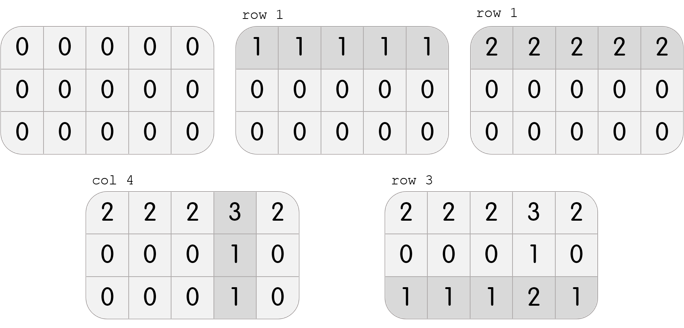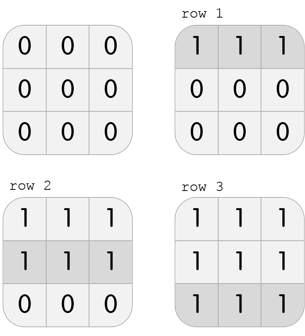On the way to school, Karen became fixated on the puzzle game on her phone!

The game is played as follows. In each level, you have a grid with n rows and m columns. Each cell originally contains the number 0.
One move consists of choosing one row or column, and adding 1 to all of the cells in that row or column.
To win the level, after all the moves, the number in the cell at the i-th row and j-th column should be equal to gi, j.
Karen is stuck on one level, and wants to know a way to beat this level using the minimum number of moves. Please, help her with this task!
The first line of input contains two integers, n and m (1 ≤ n, m ≤ 100), the number of rows and the number of columns in the grid, respectively.
The next n lines each contain m integers. In particular, the j-th integer in the i-th of these rows contains gi, j (0 ≤ gi, j ≤ 500).
If there is an error and it is actually not possible to beat the level, output a single integer -1.
Otherwise, on the first line, output a single integer k, the minimum number of moves necessary to beat the level.
The next k lines should each contain one of the following, describing the moves in the order they must be done:
- row x, (1 ≤ x ≤ n) describing a move of the form "choose the x-th row".
- col x, (1 ≤ x ≤ m) describing a move of the form "choose the x-th column".
If there are multiple optimal solutions, output any one of them.
3 5
2 2 2 3 2
0 0 0 1 0
1 1 1 2 1
4
row 1
row 1
col 4
row 3
3 3
0 0 0
0 1 0
0 0 0
-1
3 3
1 1 1
1 1 1
1 1 1
3
row 1
row 2
row 3
In the first test case, Karen has a grid with 3 rows and 5 columns. She can perform the following 4 moves to beat the level:

In the second test case, Karen has a grid with 3 rows and 3 columns. It is clear that it is impossible to beat the level; performing any move will create three 1s on the grid, but it is required to only have one 1 in the center.
In the third test case, Karen has a grid with 3 rows and 3 columns. She can perform the following 3 moves to beat the level:

Note that this is not the only solution; another solution, among others, is col 1, col 2, col 3.
题意:给你一个n行m列的二维数组,你可以对任意行或列执行一个删除操作,即使该行或列上所有数字-1,如果能使数组全为0,则输出最小操作数以及步骤,不能则输出-1.
通过思考,有以下规则:
1.一行中最小的数字,就是能对该行执行的最大操作次数,如2 3 4 3,最多操作2次后变为0 1 2 1,此后对该行无法继续操作,对于列也是一样。
2.若对所有行执行操作,等价于对所有列执行操作
3.把对所有行或所有列的同步操作优先进行,可以达到最简化的效果
最简化操作以行列数量为准,如n=2,m=4,数组如下
k+0,k+0,k+1,k+0
k+2,k+2,k+3,k+2
若要先消除k,操作行,使数组总和-m,操作列,使数组总和-n,因此行数少,则优先列,列数少,则操作行
4.对于最简化后的数组,其任意数字等于其最大行操作数与最大列操作数之和。如上述例子
0 0 1 0
2 2 3 2
第二行为2,第三列为1,其余全为0
代码如下
#include<iostream> #include<cstdio> #include<cstring> #include<algorithm> #include<cmath> #include<set> using namespace std; const int MAX=1e5+10; #define INF 0x7fffffff #define ll long long #define FOR(i,n) for(i=1;i<=n;i++) int main() { int n,m,i,j,k,ans=0,a[105][105],row[105],col[105],mark1; cin>>n>>m; for(i=1;i<=n;i++) { row[i]=INF; for(j=1;j<=m;j++) { cin>>a[i][j]; row[i]=min(row[i],a[i][j]); } } for(i=1;i<=m;i++) { col[i]=INF; for(j=1;j<=n;j++) { col[i]=min(col[i],a[j][i]); } } if(n>m) { mark1=INF; for(i=1;i<=m;i++) { ans+=col[i]; mark1=min(mark1,col[i]); } for(i=1;i<=n;i++) { row[i]-=mark1; ans+=row[i]; } } else { mark1=INF; for(i=1;i<=n;i++) { ans+=row[i]; mark1=min(mark1,row[i]); } for(i=1;i<=m;i++) { col[i]-=mark1; ans+=col[i]; } } for(i=1;i<=n;i++) { for(j=1;j<=m;j++) { if(a[i][j]!=(col[j]+row[i])) { cout<<"-1"<<endl; return 0; } } } if(n>m) { cout<<ans<<endl; for(i=1;i<=m;i++) for(j=1;j<=col[i];j++) cout<<"col "<<i<<endl; for(i=1;i<=n;i++) for(j=1;j<=row[i];j++) cout<<"row "<<i<<endl; } else { cout<<ans<<endl; for(i=1;i<=n;i++) for(j=1;j<=row[i];j++) cout<<"row "<<i<<endl; for(i=1;i<=m;i++) for(j=1;j<=col[i];j++) cout<<"col "<<i<<endl; } }